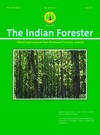Growth Performance Evaluation of Tissue Culture Raised Bamboos under Varying Space and Fertilizer Levels
DOI:
https://doi.org/10.36808/if/2017/v143i7/119028Keywords:
Tissue Culture, Productivity, Field Performance, Fertilizers.Abstract
Bamboos occur naturally in tropical, subtropical and temperate regions around the world. Next to China, India is the major grower of bamboos and many species are cultivated in different agroclimatic regions. Due to the monocarpic nature of bamboos, propagules shortage is often realized through micropropagation approaches. However, field performance of growth traits need to be ascertained with reference to spacing intervals and fertilizer requirements. This study examined 5×5m and 6×6m spacing with different fertilizers like farmyard manure, chemical fertilizers and mixture of farmyard manure and chemical fertilizers for the three important bamboos species, i.e., Dendrocalamus strictus, Pseudoxytenanthera stocksii and Bambusa bambos. At the age seven years, it was observed that among three species Bambusa bambos exhibited greater height growth (16.19±2.31m) and culm diameter (79.94±7.32) whereas Pseudoxytenanthera stocksii produced higher number of culms (39.04±5.17) with the application of farmyard manure and chemical fertilizers. Spacing of 5×5m was suitable for Dendrocalamus strictus and Pseudoxytenanthera stocksii whereas, 6×6m was essential for Bambusa bambos for increased productivity. Further, yield potential can be enhanced with the application of farmyard manure and chemical fertilizers.References
Agnihotri R.K., Mishra J. and Nandi S.K. (2009). Improved in vitro shoot multiplication and rooting of Dendrocalamus hamiltonii Nees et Arn. ex Munro: production of genetically uniform plants and field evaluation. Acta Physiol Plant, 31:961–967
Banerjee H., Dhara P.K. and Mazumdar D. (2009). Bamboo (Bambusa spp.) based agroforestry systems under rainfed upland ecosystem. J. Crop Weed, 5: 286-290
Devarumath R.M., Doule R.B., Kawar P.G., Naikebawane S.B. and Nerkar Y.S. (2007). Field Performance and RAPD analysis to evaluate genetic fidelity of tissue culture raised plants vis-a-vis conventional sets derived plants of sugarcane. Sugar Tech, 9:17-22
Dibi K., Boko C., Obouayeba S., Gnagne M., Dea G.B., Carron M.P. and Anno A.P. (2010). Field growth and rubber yield of in vitro micropropagated plants of clones PR 107, IRCA 18 and RRIM 600 of Hevea brasiliensis (Muëll.-Arg.). Agric. Biol. J. N. Am,1:1291-1298
Gantait S., Pramanik B.R. and Banerjee M. (2016). Optimization of planting materials for large scale plantation of Bambusa balcooa Roxb.: Influence of propagation methods. J. Saudi Soc Agri. Sci., doi:10.1016/j.jssas.2015.11.008
Grossnickle S.C. and Folk R.S. (2007). Field performance potential of a somatic interior spruce seedlot. New For., 34:51-72
Kittur B.H., Sudhakara K., Mohan Kumar B., Kunhamu T.K. and Sureshkumar P. (2015). Bamboo based agroforestry systems in Kerala, India: performance of turmeric (Curcuma longa L.) in the sub canopy of differentially spaced seven year-old bamboo stand. Agroforestry Sys., 90:237-250
Mishra Y., Rana P.K., Sonkar M.K. and Ansari S.A. (2015). Comparative Field Performance of Micropropagated Plantlets of Three Bamboo Species. Indian Forester, 141:739-744
Muniswamy B., Sreenath H.L., Samuel S.D. and Jayarama J. (2015). In vitro multiplication of Coffea arabica F1 hybrid (S.2800) and its performance in the field. Short Sci. Rep. J. Plant Crops, 43: 225-230
Piouceau J., Bois G., Panfili F., Anastase M., Dufossé L. and Arfi V. (2014). Effects of high nutrient supply on the growth of seven bamboo species. Inter. J. Phytoremediation, 16:1042-57
Salvi N.D., George L. and Eapen S. (2002). Micropropagation and field evaluation of micropropagated plants of turmeric. Plant Cell Tissue Organ Cult., 68: 143–151
Sandhu S.K., Gosal S.S., Thind K.S., Uppal S.K., Sharma B., Meeta M., Singh K. and Cheema G.S. (2009). Field performance of micropropagated plants and potential of seed cane for stalk yield and quality in sugarcane. Sugar Tech., 11:34-38
Sidhu D.S. and Dhillon G.P.S. (2007). Field performance of ten clones and two sizes of planting stock of Populus deltoides on the Indo-gangetic plains of India. New For., 34:115–122
Singh S.R., Singh R., Kalia S., Dalal S., Dhawan A.K. and Kalia R.K. (2013). Limitations, progress and prospects of application of biotechnological tools in improvement of bamboo—a plant with extraordinary qualities. Physiol. Mol. Biol. Plants, 19:21–41
Sood A., Ahuja P.S., Sharma M., Sharma O.P. and Godbole S. (2002). In vitro protocols and field performance of elites of an important bamboo Dendrocalamus hamiltoniiNees et Arn. ex Munro. Plant Cell Tissue Organ Cult., 71:55–63
Veller C., Nowak M.A. and Davis C.C. (2015). Extended flowering intervals of bamboos evolved by discrete multiplication. Ecology letters, 18:653-659
Yasodha R., Sumathi R. and Gurumurthi K. (2004). Micropropagation for quality propagule production in plantation forestry. Ind. J. Biotech., 3:159-170
Downloads
Downloads
Published
How to Cite
Issue
Section
License
Unless otherwise stated, copyright or similar rights in all materials presented on the site, including graphical images, are owned by Indian Forester.





